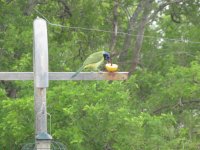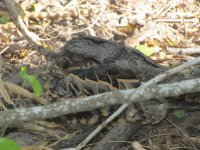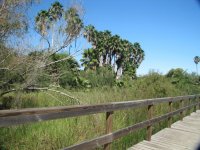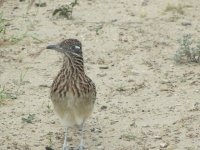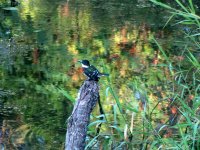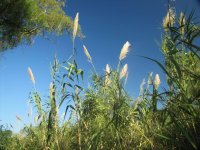veagle
Well-known member
I recently had a business meeting in San Antonio, and have planned for a long time to visit the Lower Rio Grande Valley. All the usual specialty target species, and at the same time, I was hoping to hit two milestones that seemed within reach. First, I was pretty confident that I could get 27 new year birds, giving me over 400 for the first time. And secondly, I was hopeful that with 23 new life birds, I might hit 500 ABA birds.
My principal resources in planning the trip were a copy of the ABA Bird Finding Guide to the Rio Grande Valley, eBird, and personal recommendations from a variety of people who have spent time in the Valley.
My general plan was to rent a car in San Antonio on Thursday, October 27, 2011, and drive down to McAllen, where I would stay the first two nights. My first day, I wanted to hit the western area, including Falcon State Park, Salineno, and Roma, and finish the day at Bentsen - Rio Grande State Park. Then I would continue working eastward, thinking I might visit Santa Ana NWR, and some combination of Frontera, Allen William’s backyard, and Estero Llano Grande SP. I would move to Harlingen after that second day, and hit Sabal Palm and South Padre Island on my third and last day. During the business meeting, I did get a brief chance to look around the hotel and managed to pick up my first new bird of the trip, a Black Crested Titmouse, as well as Blue-Headed Vireo, Northern Cardinal, Ruby-throated Hummingbird, Great-tailed Grackle, Bewick’s Wren, Field Sparrow, and numerous Turkey Vultures overhead.
The trip started on an odd note. Showing up to pick up my rental, I was informed that the only thing they had was a BIG pick-up truck. Being the only male in Western South Dakota without a pick-up, I thought this was ironic. And I was not looking forward to using this gas-guzzler. But I was able to negotiate a free tank of gas (God knows how many gallons THAT was). And as I drove south towards the Valley, I started getting into this – made me feel like a real Texan, listening to Country Music, drivin’ my pick-up. Heck, maybe I should get a shot-gun and go all the way. No – have to draw the line somewhere.
In any event, shortly after a delicious repast at McDonalds, I spotted the unique silhouette of the Scissor-tailed Flycatcher, a bird I have wanted to see for quite a while. And I was hoping very much to have better looks than at 75MPH along US 281. Also got a quick look at a couple of Crested Caracaras, the first of several that I would see.
My son, who up until recently was traveling nearly all the time, has accumulated massive “points” with various hotel chains, and put me up, his treat, at the Hampton Inn, in McAllen. Nice place, centrally located. Planning an early start, my plan was to try to be at Salineno, on the the Rio Grande River, at or about dawn.
My principal resources in planning the trip were a copy of the ABA Bird Finding Guide to the Rio Grande Valley, eBird, and personal recommendations from a variety of people who have spent time in the Valley.
My general plan was to rent a car in San Antonio on Thursday, October 27, 2011, and drive down to McAllen, where I would stay the first two nights. My first day, I wanted to hit the western area, including Falcon State Park, Salineno, and Roma, and finish the day at Bentsen - Rio Grande State Park. Then I would continue working eastward, thinking I might visit Santa Ana NWR, and some combination of Frontera, Allen William’s backyard, and Estero Llano Grande SP. I would move to Harlingen after that second day, and hit Sabal Palm and South Padre Island on my third and last day. During the business meeting, I did get a brief chance to look around the hotel and managed to pick up my first new bird of the trip, a Black Crested Titmouse, as well as Blue-Headed Vireo, Northern Cardinal, Ruby-throated Hummingbird, Great-tailed Grackle, Bewick’s Wren, Field Sparrow, and numerous Turkey Vultures overhead.
The trip started on an odd note. Showing up to pick up my rental, I was informed that the only thing they had was a BIG pick-up truck. Being the only male in Western South Dakota without a pick-up, I thought this was ironic. And I was not looking forward to using this gas-guzzler. But I was able to negotiate a free tank of gas (God knows how many gallons THAT was). And as I drove south towards the Valley, I started getting into this – made me feel like a real Texan, listening to Country Music, drivin’ my pick-up. Heck, maybe I should get a shot-gun and go all the way. No – have to draw the line somewhere.
In any event, shortly after a delicious repast at McDonalds, I spotted the unique silhouette of the Scissor-tailed Flycatcher, a bird I have wanted to see for quite a while. And I was hoping very much to have better looks than at 75MPH along US 281. Also got a quick look at a couple of Crested Caracaras, the first of several that I would see.
My son, who up until recently was traveling nearly all the time, has accumulated massive “points” with various hotel chains, and put me up, his treat, at the Hampton Inn, in McAllen. Nice place, centrally located. Planning an early start, my plan was to try to be at Salineno, on the the Rio Grande River, at or about dawn.




